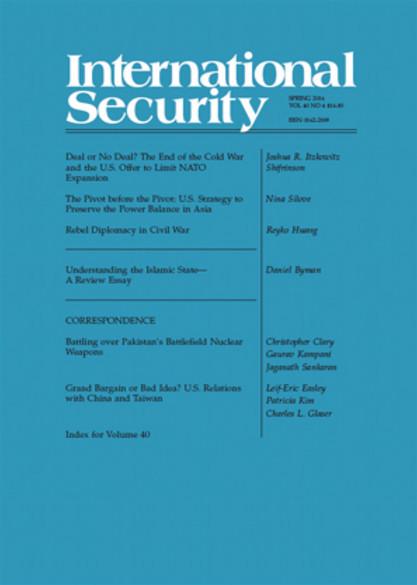Correspondence: Military-Technological Imitation and Rising Powers
IF 4.8
1区 社会学
Q1 INTERNATIONAL RELATIONS
引用次数: 0
Abstract
Andrea Gilli and Mauro Gilli should be lauded for making clear how the growing complexity of capital-intensive military platforms such as aghter jets hinders states, such as China, seeking to mimic the United States.1 Gilli and Gilli join a long line of thinkers, myself included, who argue that military technology does not always diffuse easily and that the characteristics of technologies matter in driving how those technologies spread and inouence international politics.2 Although there is much to like about Gilli and Gilli’s article, their analysis has some theoretical limitations with implications for policymaking. First, because Gilli and Gilli evaluate only military technology adoption, they miss the broader ways that human capital, tacit knowledge, and organizational practices shape military power. Gilli and Gilli’s unit of analysis is military-technological superiority (p. 145), suggesting a technologically determinist view of military power. Technology, however, is only a subset of how states generate military power. More important for victory and defeat, on average, is how states develop and employ their capabilities on the battleaeld.3 Gilli and Gilli’s ignoring of the organizational component of military power is relevant because another reason why a country such as China might struggle to adopt some of today’s key military capabilities involves a lack of tacit organizational and Correspondence: Military-Technological Imitation通信:军事技术模仿与新兴大国
安德里亚·吉利和毛罗·吉利应该受到赞扬,因为他们清楚地表明,资本密集型军事平台(如喷气式飞机)的日益复杂,如何阻碍了中国等国寻求模仿美国。吉利和吉利加入了包括我在内的一长列思想家的阵营,他们认为军事技术并不总是容易传播的,技术的特性在推动这些技术如何传播和影响国际政治方面起着重要作用尽管吉利和吉利的文章有很多值得喜欢的地方,但他们的分析有一些理论上的局限性,可能会对政策制定产生影响。首先,因为Gilli和Gilli只评估军事技术的采用,他们错过了人力资本、隐性知识和组织实践塑造军事力量的更广泛的方式。Gilli和Gilli的分析单位是军事技术优势(第145页),提出了军事力量的技术决定论观点。然而,技术只是国家如何产生军事力量的一个子集。一般来说,决定胜负的更重要因素是各国如何在战场上发展和运用自己的能力吉利和吉利对军事力量的组织成分的忽视是相关的,因为像中国这样的国家可能难以采用当今一些关键军事能力的另一个原因涉及缺乏默契的组织和对应:军事技术模仿
本文章由计算机程序翻译,如有差异,请以英文原文为准。
求助全文
约1分钟内获得全文
求助全文
来源期刊

International Security
Social Sciences-Law
CiteScore
7.40
自引率
10.00%
发文量
13
期刊介绍:
International Security publishes lucid, well-documented essays on the full range of contemporary security issues. Its articles address traditional topics of war and peace, as well as more recent dimensions of security, including environmental, demographic, and humanitarian issues, transnational networks, and emerging technologies.
International Security has defined the debate on US national security policy and set the agenda for scholarship on international security affairs for more than forty years. The journal values scholarship that challenges the conventional wisdom, examines policy, engages theory, illuminates history, and discovers new trends.
Readers of IS discover new developments in:
The causes and prevention of war
U.S.-China relations
Great power politics
Ethnic conflict and intra-state war
Terrorism and insurgency
Regional security in Africa, Asia, Europe, and Latin America
U.S. foreign and defense policy
International relations theory
Diplomatic and military history
Cybersecurity and defense technology
Political economy, business, and security
Nuclear proliferation.
 求助内容:
求助内容: 应助结果提醒方式:
应助结果提醒方式:


